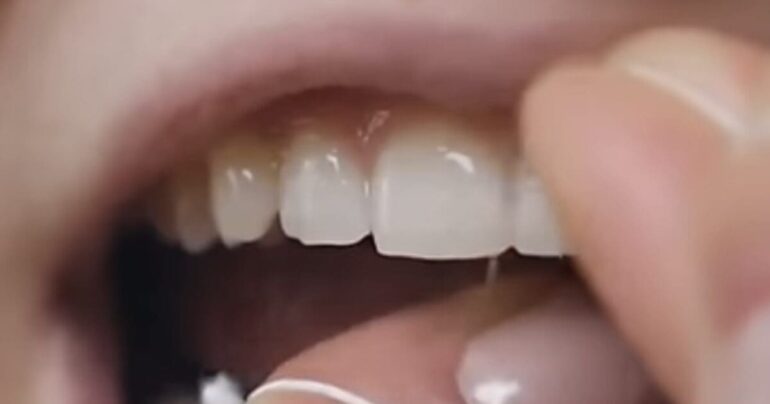🔴 Website 👉 https://u-s-news.com/
Telegram 👉 https://t.me/usnewscom_channel
The National Institutes of Health (NIH) said vaccines delivered by dental floss might be a “promising” alternative to injectable vaccines.
“Most vaccines are given via needle jabs. But many of us would appreciate needle-free options. An NIH-supported study suggests that vaccines delivered by dental floss might be a promising and practical alternative to injectable vaccines. However, additional study is needed to evaluate this approach,” the NIH said.
Most vaccines are given via needle jabs. But many of us would appreciate needle-free options. An NIH-supported study suggests that vaccines delivered by dental floss might be a promising and practical alternative to injectable vaccines. However, additional study is needed to… pic.twitter.com/Dr4NgDbsab
— NIH (@NIH) August 30, 2025
More from the NIH:
Earlier studies have suggested the mouth could be a good place for delivering vaccines. Vaccines delivered to the mouth might trigger immunity not only in the bloodstream but also in the mucosal tissues that line our body surfaces. Those surfaces are where viruses often enter. But attempts to deliver vaccines to the cheeks or under the tongue have had mixed results.
In a new study, researchers led by Dr. Harvinder Singh Gill at North Carolina State University wanted to test the potential for a vaccine delivered instead to the gums. They focused on the gingival sulcus, the tiny groove between the teeth and gums. The base of the gingival sulcus has a thin lining of tissue called the junctional epithelium. Because the junctional epithelium is leakier, or more permeable, than other tissues, they thought it might be possible to deliver an effective immune-boosting vaccine there using dental floss. Their findings appeared in Nature Biomedical Engineering on July 22, 2025.
The scientists coated flat tape dental floss from a local pharmacy with a variety of vaccine molecules and used it to floss the tiny teeth of mice in the lab. They found that the compounds, including peptides, proteins, and inactivated influenza viruses, successfully transferred into gum tissue. Floss coated with the influenza virus stimulated immune responses and the production of antibodies in the mice. The researchers saw strong immune activity in multiple organs, plus antibodies in the bloodstream as well as the mucosal surfaces.
The team next tested whether the influenza vaccine protected mice from otherwise fatal infection with influenza. The floss-based vaccine fully protected the mice. It stimulated immunity better than a vaccine delivered under the tongue and about as well as one delivered into the nose.
X users reacted to the vaccine delivery alternative:
Well – that’s a little terrifying. Thanks. Guess we’re learning that we’re going to get innoculated in other ways now. Our food – OUR FREAKING DENTAL FLOSS – WONDERFUL
Excuse me – I need another tin foil hat, I guess— Ebett (@EbetPittman) August 30, 2025
This should make us wonder what they’re already putting on our floss…
— Millie (@3uca1yptus_) August 30, 2025
That’s an excellent way to get people to stop flossing their teeth.
— COVID-Reporter (@C19Reporter) August 30, 2025
I can see it now.
Warning, this dental floss may cause myocarditis, sudden death, and other unforeseen medical issues.— James Bode🟥🟥 (@MisterJamesBode) August 30, 2025
Absolutely not! Putting it in an everyday product like dental floss makes no sense except to deceive. Just give the vaccine orally to those who willingly choose.
— CLP (@CindyLP8) August 30, 2025
“We found that applying vaccine via the junctional epithelium produces far superior antibody response on mucosal surfaces than the current gold standard for vaccinating via the oral cavity, which involves placing vaccine under the tongue,” Rohan Ingrole, one of the study’s authors, stated.
“The flossing technique also provides comparable protection against flu virus as compared to the vaccine being given via the nasal epithelium,” Ingrole added.
Gill called the vaccine delivery method “extremely promising.”
“Most vaccine formulations cannot be given via the nasal epithelium—the barrier features in that mucosal surface prevent efficient uptake of the vaccine,” Gill added.
Exclusive: A new study envisions future needle-free vaccines that trigger protective immune responses using a special kind of coated dental floss.
Learn more: https://t.co/JOZ03O792w pic.twitter.com/bJPjeg5u7A
— Science Magazine (@ScienceMagazine) July 29, 2025
Read the study’s abstract at Nature Biomedical Engineering:
The oral cavity is an accessible site for vaccination, but its sublingual and buccal sites have limited vaccine uptake. Here we show that flat tape dental floss can deliver vaccines through the junctional epithelium of the gingival sulcus, exploiting its naturally leaky properties. Floss-based vaccination delivered protein, inactivated virus, peptide-presenting immunogenic nanoparticles and messenger RNA. In mice, gold nanoparticles functionalized with a peptide derived from the ectodomain of the transmembrane matrix 2 protein of human influenza virus stimulated local lymph nodes, increased CD4+T cells in lymph nodes, lungs and spleen, and boosted antibody-secreting cells in the bone marrow. Floss-based immunization induced strong and sustained immune activation across multiple organs, robust systemic and mucosal antibody responses, and durable protection against lethal influenza infection, independent of age, food and liquid consumption. Floss-based vaccination was superior to sublingual and comparable with intranasal vaccination. In human participants, fluorescent dye delivered via floss picks effectively reached gingival sulcus, supporting clinical feasibility. These findings establish floss-based vaccination as a simple, needle-free strategy that enhances vaccine delivery and immune activation compared with existing mucosal immunization methods.

